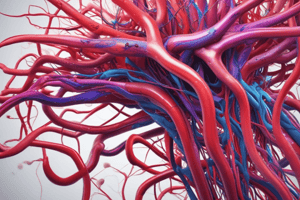Podcast
Questions and Answers
What is the thickest layer in the vessel wall of arteries?
What is the thickest layer in the vessel wall of arteries?
The thickest layer in the vessel wall of arteries is the media.
What is the role of mechanoreceptors in the body?
What is the role of mechanoreceptors in the body?
Mechanoreceptors detect changes in pressure of blood.
What is the main function of sinusoidal capillaries?
What is the main function of sinusoidal capillaries?
Sinusoidal capillaries allow for the exchange of material.
In which type of capillaries is the blood-brain barrier formed?
In which type of capillaries is the blood-brain barrier formed?
What happens to capillaries during relaxed state?
What happens to capillaries during relaxed state?
What is the primary function of muscular venules?
What is the primary function of muscular venules?
What is the backup mechanism for blood flow in case an artery or vein gets blocked?
What is the backup mechanism for blood flow in case an artery or vein gets blocked?
What is the relationship between resistance to change and blood pressure?
What is the relationship between resistance to change and blood pressure?
What is the formula to calculate pulse pressure?
What is the formula to calculate pulse pressure?
Flashcards are hidden until you start studying
Study Notes
Arterial Walls vs. Veins
- Arterial walls are thicker than veins due to higher blood pressure (BP)
- Arteries have a thicker layer of smooth muscle and elastic fibers, allowing them to recoil and maintain BP
Blood Pressure Regulation
- Prostacyclin is produced by the endothelium to relax smooth muscle and reduce BP
- BP must be high enough to reach all organs and tissues, but too high can cause damage (e.g., stroke, hardening of vessels)
Blood Vessel Structure
- Arteries have a thickest layer of tunica media, which is composed of smooth muscle and elastic fibers
- Veins have a thinner layer of tunica media and are more flexible
- Capillaries have a single layer of endothelial cells, allowing for exchange of materials between blood and tissues
Capillary Beds
- Capillary beds have a network of capillaries with a high surface area, allowing for efficient exchange of oxygen and nutrients
- Micropressure is higher in capillaries, causing them to be open and relaxed
- Contraction of precapillary sphincters reduces blood flow and increases BP
Veins and Blood Flow
- Veins have one-way valves to prevent backflow and ensure blood flow towards the heart
- Skeletal muscles help push blood towards the heart through contraction
- If an artery or vein becomes blocked, blood can flow through alternative routes (collateral circulation)
Blood Pressure Measurement
- Pulse pressure is the difference between systolic and diastolic BP
- Mean arterial pressure (MAP) is the average BP, calculated as (systolic BP + 2 x diastolic BP) / 3
- Normal BP ranges: systolic 120 mmHg, diastolic 75 mmHg, MAP 90 mmHg
Studying That Suits You
Use AI to generate personalized quizzes and flashcards to suit your learning preferences.




